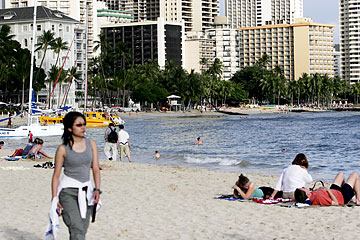
RICHARD WALKER / RWALKER@STARBULLETIN.COM
Signs warning of contaminated water were removed yesterday from Waikiki beaches, yet swimmers were few along popular shorelines like the Royal Hawaiian Hotel.
|
|
State reopens Waikiki beaches
Health officials credit the sun, wind and tides for quickly clearing contaminated waters
State officials reopened Waikiki beaches and city crews removed contaminated-water warning signs yesterday after tests showed that bacterial counts in the sewage-soiled ocean were falling.
"The levels have returned to normal, ambient levels," said Watson Okubo, supervisor for the monitoring and analysis section of the state Department of Health's Clean Water Branch.
Beaches between the Hilton Hawaiian Village and the Sheraton Moana Surfrider reopened to the public yesterday afternoon after state health officials determined that waters were safe, based on the steady decline in the bacterial counts. More than 50 warning signs were removed.
Last Wednesday, warning signs were posted at Duke Kahanamoku Beach in front of the Hilton Hawaiian Village and Fort DeRussy Beach in front of the Hale Koa Hotel because of high bacterial counts after a massive sewage spill that began March 24. About 48 million gallons of raw sewage were diverted into the Ala Wai Canal when a 42-inch force main ruptured on Kaiolu Street. It was the largest raw sewage spill in the state's history.
On Sunday night, officials closed Waikiki beaches after a spike in bacterial counts following Friday's heavy downpour, which caused additional Waikiki sewage spills, estimated at 1.8 million gallons. Debris also flowed into the canal and the ocean.
The recent sunny weather has played a key role in the bacterial count drop, health officials said. The tides and winds were also favorable in moving contaminated waters away from the shoreline, said Kurt Tsue, spokesman for the Department of Health.
The current flow is heading out to sea and slightly toward Diamond Head.
Okubo noted the fast, steady decline in bacterial counts despite the massive amount of sewage and the erratic weather.
"I think we got off pretty lucky (considering) the amount of waste water that entered the Ala Wai. It could've been 10 times worse," he said, noting that Friday's heavy rains helped flush out the raw sewage that filled the canal.
Okubo said he and his staff learned a lot in recent weeks relating to the sewage spill. At surf spots, high salinity levels were detected by state health officials. "We assumed the sewage would lessen the salinity, but at surf sites, that wasn't the case," he said.
Bacterial count levels remain high for surf spots at the mouth of the Ala Wai Channel and off Waikiki. "The surf spots are still not deemed safe," Tsue said.
Warning signs will remain posted at areas near Ala Moana Bowls, Rock Pile, Kaisers, Fours, Threes, Pops and Canoes. Health officials recommend that surfers stay out of the popular surf spots.
Yesterday, some visitors ventured into the water.
Standing on the shoreline by the Royal Hawaiian Hotel, Idaho native Elizabeth Goetzinger took photos of her two grandchildren -- Lunden Young, 13, and Michael Young, 10 -- while they played in the water. Goetzinger said yesterday was the first time her grandchildren had a chance to play in the water since they arrived.
"It looks safe," she said. "I am going to take a dip in the water." Goetzinger said her grandchildren wanted to swim two days ago, when warning signs were posted.
Even with the warning signs gone, a lifeguard sitting in a tower between the Royal Hawaiian Hotel and the Sheraton Moana Surfrider said the public should be cautious and wait a couple of days before going into the water.
Warning signs remain posted on the Windward Oahu coastline. Signs are posted at Bellows Beach, Kuliouou/Maunalua Bay Beach Park, Kaneohe Bay, Wailupe and Kailua Beach Park, Tsue said. The Department of Health will continue to collect water samples along the Waikiki shoreline and its surf spots as well as on the Windward Coast.

